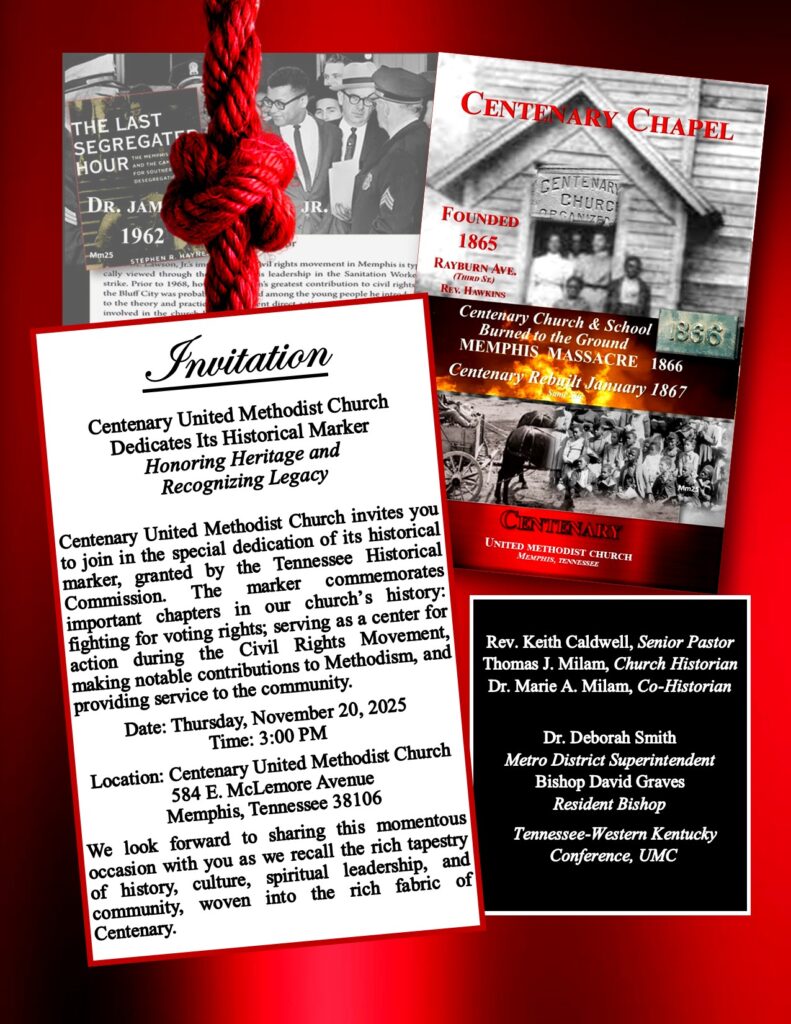센테니얼 연합감리교회가 역사적인 표지석 헌납식에 여러분을 초대합니다. 헌정식은 2025년 11월 20일 목요일 오후 3시에 교회에 위치한 다음 장소에서 열립니다. 584 E. 맥레모어 애비뉴, 멤피스, 테네시주.
테네시 역사 위원회의 승인을 받은 이 기념비는 목회자와 교인들의 희생, 투쟁, 용기, 회복력에 대한 경의를 표하며, 진보와 자유에 따르는 대가를 강력하게 상기시키는 역할을 합니다. 100주년 기념 교회와 학교는 1865년 감리교 북부 성공회가 멤피스 시내 인근의 라번 스트리트에 설립했습니다. 설립 당시부터 목회자와 교인들은 시민 운동에 참여했으며 교회는 지역사회에 확실한 영향을 미쳤습니다. 1866년 멤피스 대학살 사건으로 불에 탄 센테니얼은 1967년 1월에 재건되어 사역의 사명을 이어갔습니다. 이 학교의 학생들은 멤피스 최초의 흑인 교사가 되었고, 흑인 아이들을 위한 최초의 유치원이 목사관에 설립되었으며, 멤피스 최초의 흑인 보이스카우트 대대가 교회에서 조직되었습니다.
1940년 인종 갈등이 최고조에 달했을 때, 목사이자 지역 NAACP 회장인 H. B. 깁슨 박사와 교인들은 투표권을 위한 투쟁에 적극적으로 참여했습니다. 1960년대에는 지역사회에서 센테너리 교회의 역할이 매우 중요했으며, 담임 목사인 제임스 M. 로슨 주니어 박사가 이를 주도했습니다. 1966년, 센테너리는 제임스 메러디스의 전략적 계획 수립을 위한 장소로 사용되었습니다. 두려움에 맞서는 행진메러디스가 총에 맞은 후에도 미시시피주 멤피스에서 잭슨까지 행진은 계속되었습니다. 100주년 회원인 A. W. 윌리스 주니어 변호사는 메러디스의 지역 변호사였습니다.
1968년 2월, 흑인 환경미화원과 시 공무원 간의 오랜 갈등이 폭발하자 센테니얼의 목사 제임스 로슨 목사는 멤피스 시장과 면담을 갖고 적절한 근무 조건을 제공할 것을 촉구했습니다. 합의가 이루어지지 않자 노동자들은 센테너리에서 집회를 열었고, 결국 파업을 선언했습니다. 로슨 박사는 노동자들을 돕기 위해 마틴 루터 킹 주니어 박사를 멤피스로 초청했고, 교회에서 전략 회의가 열렸습니다. 킹 박사는 1968년 4월 4일 로레인 모텔에서 총에 맞아 사망했습니다. 100주년 회원인 클라라 에스터는 발코니에서 그를 도우려 했습니다. 또 다른 100주년 회원인 로버트 S. 루이스 주니어는 킹 박사의 시신을 밴스 애비뉴에 있는 그의 장례식장에서 매장할 준비를 했습니다. 킹 박사의 비극적인 죽음 이후 센테니얼 교회는 전국적인 주목을 받으며 역사적 영향력과 봉사의 전통을 굳건히 지켜왔습니다. 교회는 그간의 여정을 되돌아보며 공유된 역사와 공동의 비전을 바탕으로 한 미래를 기대합니다.

센테니얼 UMC 제출
